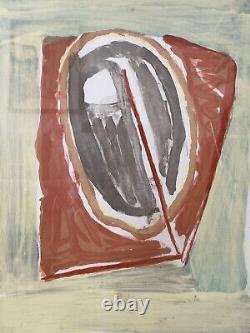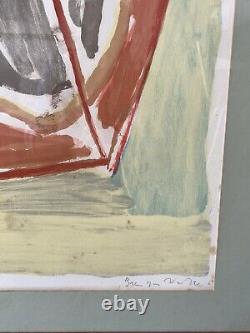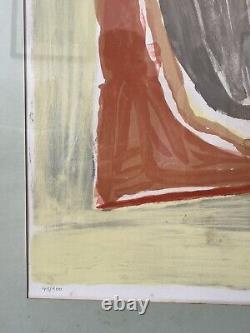
- Index
- Authenticity
- Characteristics
- Genre
- Abstract (92)
- Abstrait (363)
- Art Deco (52)
- Art Déco (109)
- Art Moderne (10)
- Art Naïf (30)
- Art Nouveau (97)
- Cubisme (26)
- Expressionism (53)
- Expressionnisme (162)
- Fauvisme (13)
- Modern (53)
- Moderne (18)
- Naive Art (21)
- Pop Art (40)
- Street Art (62)
- Streetart (87)
- Surrealism (23)
- Surréalisme (103)
- Symbolisme (14)
- Other (1417)
- Style
- Theme
- Abstract (108)
- Animals (32)
- Architecture (3)
- Calligraphy (2)
- Character (158)
- Erotic Drawings (2)
- Family (2)
- Fantastic (5)
- Flower, Tree (11)
- Genre Scene (9)
- History, War (2)
- Landscape (38)
- Music (6)
- Narrative Figuration (2)
- Normandy (3)
- Nude (5)
- Religion, Mythology (7)
- Seascape, Boat (4)
- Sport (2)
- Still Life (8)
- Other (2436)
- Type
Bram VAN VELDE Original Signed Numbered Lithograph Abstract Parisian School










Six-color lithograph on Arches signed in pencil at the bottom right "Bram van Velde" and numbered in pencil at the bottom left 41/100. Dimensions with frame: 84 cm x 66 cm. Reference: Mason & Putman, Bram van Velde. Condition: good (see photos, some stains). Bram van Velde was born on October 19, 1895 in Zoeterwoude, near Leyde. A self-taught artist, he was drawn to painting at a very young age, at twelve he worked as an apprentice in an interior decoration workshop Schaijk & Kramers, in The Hague. Bram van Velde was encouraged in his art by the Kramers family, collectors and enthusiasts sensitive to his talent. They would regularly sponsor him until around 1934.
His career took off, in February 1927 he traveled to Bremen to exhibit his works. Bram Van Velde, along with his brother Geer, was admitted to the Salon des Indépendants in Paris. Initially influenced by German expressionists, he later received the influence of the Fauves in Paris.
Bram van Velde worked until he achieved a personal abstraction, which he never deviated from. In a series of compositions with fruits in front of the window, he dispersed the form on the surface and abolished the distance between interior and exterior, with forms conceived as signaling elements caught in a system of contours and circles tending towards the interlocking of surfaces.
He distinguished himself from French artists who arrived at abstract style through impressionism and cubism. It was in 1939 that the artist created his own plastic language, with three large gouaches that would establish the autonomy of his art. A great autonomy of painting is affirmed. After being deeply affected by the terror of the war, van Velde ceased all pictorial activity from 1941 to 1945. In the post-war period, he was fully in control of the plastic language that would characterize his entire oeuvre. The painter's internal tensions materialized a highly personal conception of space. Bram van Velde enjoyed incorporating fluidity into his work, often giving a luminous transparency to his compositions. It wasn't until the 1960s, when he settled in Geneva, that the artist gained some recognition. From 1961, the pace of exhibitions accelerated. A first film by Jean-Michel Meurice was made about his life.In October 1964, the young author Charles Juliet visited him for the first time. Van Velde oscillated between Paris and Geneva, where he began painting before settling there in 1967. The series of Prisunic engravings overseen by Jacques Putman marked the beginning of lithograph production, which would number over 400 prints by his death.
In 1973, he painted some large gouaches in La Chapelle-sur-Carouge, which were like a final "wild" deployment of color in his work. Aimé Maeght then included him in his gallery.
